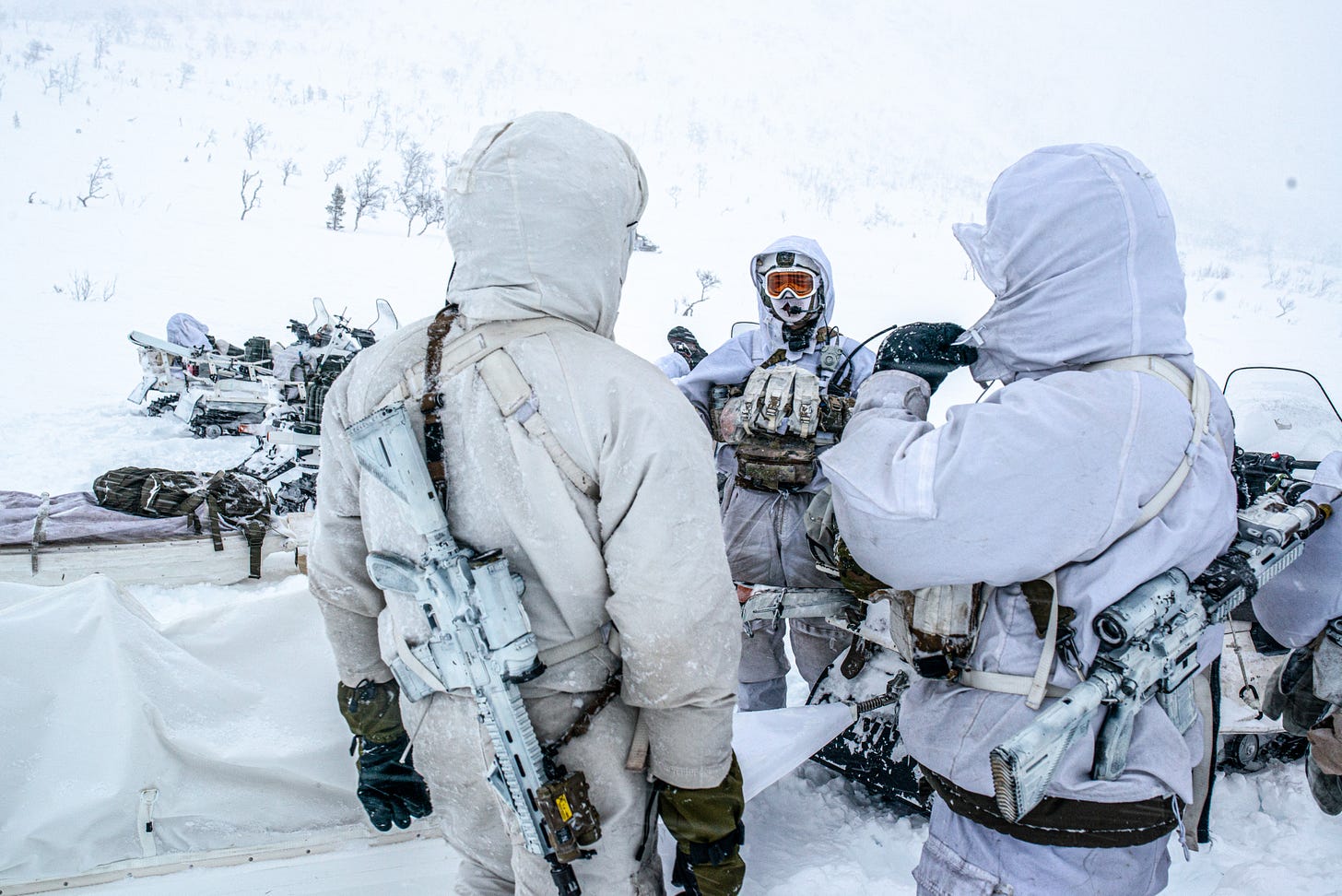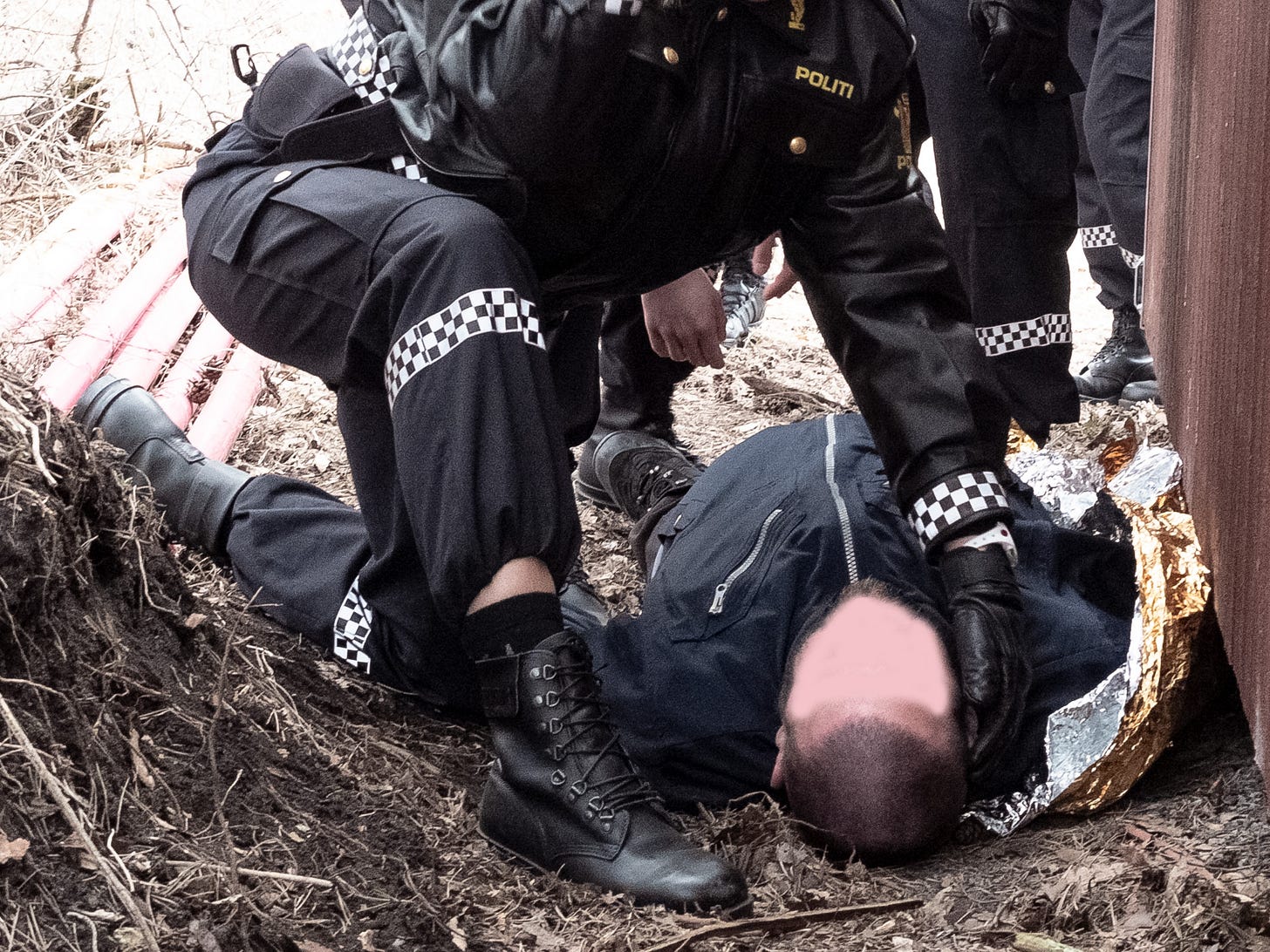June Newsletter
Read about our research, cold water immersion, safe swimming and why SOF operators are so good.
As of this newsletter, data collection from the Arctic 100-day exercise has concluded. The team is back in civilization following their unsupported mission in the Arctic. Upon their return, they were immediately met by our group of scientists, who conducted various tests over three days. After that, they were released for a few weeks, and we have just completed a recovery testing.
So what have we actually done?
We conducted this study similarly to others. However, this particular exercise is unique. Scientific principles remain relevant for us as researchers. Before beginning the exercise, we assessed the operators to establish a baseline. We repeated the same testing immediately after they completed the exercise. Additionally, we conducted another test session several weeks later to evaluate their recovery and when they return to normal values.
We have also done testing while they were in operation in the Arctic, as well as organized some medical- and rescue operations training for them. For example, we made a simulated crash site with two shoot-down pilots that needed an extremely long and hard evacuation in rough weather and terrain.
In summary, we’re conducting VO2max testing, collecting blood samples for biomarkers, assessing lung function, and evaluating strength and power. We’re also looking into nutrition, DXA body composition, psychological testing, and so much more. It’s exciting to see all the valuable data we gather, and I feel proud to lead the data collection.
We aim to share and publish as much data as possible—some in reports, but hopefully much of it in scientific journals. The research journey is painfully slow, so I cannot provide an estimate on when the data will be available.
-------
Do you know what makes Special Forces Operators special?
Years ago, I was asked by a Special Force group to be an instructor for a few days of training in prehospital emergency medical procedures during high-stress situations. I came there believing they would benefit massively from training with someone like me. An experienced rescue paramedic with lots of real-world practice.
It didn't take long before I realized they were much better than I had anticipated. With a rapidly adjusted self-image, I was able to continue training with them. A little more humble and much more impressed by their skills.
This question has intrigued me for many years. Why are the SOF operators so good in doing what they do?
While you might think they have the most advanced gear, unlimited access to all the new gadgets, and all available technology at hand, the real reason might be something else.
While I certainly don't know the answer to everything that makes Special Forces unique, a few recent studies could point us in the right direction.
A recent study investigated shooting performance under heavy stress among Norwegian Naval Special Forces. SOF operators are the best-trained warriors around the world. And this study found that they could also hit targets with high accuracy during a high-stress operation.
A study on final-year police students at the Police Academy in Stavern, Norway, showed, among other things, that students with better physical performance perform better in high-stress situations.
There are probably many who believe that special techniques are used or that lots of fancy gear and gadgets are available among SOF communities. While this might be a part of it all, the truth is probably its hard training and practice make a difference. Special Forces are particularly good at common warrior tasks.
The truth is likely that training and practice make the difference.
And I believe we can learn much from this. First Responders, Police, military, Rescue groups and others could benefit hugely from incorporating training and practice into their daily routines. Because this is what makes the difference.
Do you agree?
If you want to read more, here are the references mentioned, from some good colleagues:
Buskerud JE, Abrahamsen FE and Solberg PA (2022) Physical Stress and Determinants of Shooting Performance Among Norwegian Special Forces Operators. Front. Psychol. 13:894169. doi: 10.3389/fpsyg.2022.894169
Sandvik, A. M., Gjevestad, E., Aabrekk, E., Øhman, P., Kjendlie, P.-L., Hystad, S. W., Bartone, P. T., Hansen, A. L., & Johnsen, B. H. (2020). Physical fitness and psychological hardiness as predictors of parasympathetic control in response to stress: A Norwegian police simulator training study. Journal of Police and Criminal Psychology, 35(4), 504–517. https://doi.org/10.1007/s11896-019-09323-8
-------
Cold Water Immersion
One of the questions I most often get asked is whether cold water dips are good for you.
In Norway, as in many parts of the world, dipping in cold water has gained enormous popularity. There are numerous stories and anecdotes about the benefits this has for the body and mind. Several people have made their living on this and there are many books on the subject.
At the moment, I feel that this is a lot of hype and not much data.
It is difficult to find credible evidence for the benefits of cold water. Many studies have been conducted, and several are ongoing. However, to the best of my knowledge, they do not provide convincing evidence regarding the benefits of cold water. Some minor evidence exists, primarily in the field of psychology.
Another popular thing among athletes, is using cold-water immersion after exercise. This is supposedly helping recovery. However, a recent study finds otherwise. The study found that cold-water immersion after exercise significantly reduces muscle microvascular blood flow. This lower blood flow is strongly connected to less protein building in the muscle from ingested amino acids.
The study concludes that post-exercise cold-water immersion limits nutrient delivery and should be avoided if you want to maximize muscle recovery and adaptation from resistance training. Study is found here: https://journals.lww.com/10.1249/MSS.0000000000003723
----------
Do you use reflective foils for hypothermia?
Reflective foils, often known as "Space blankets," have been a standard component of first aid kits since the 1960s as a means of preventing hypothermia. It was created by NASA to aid in space exploration. But does it accomplish its goals?
The space blanket is claimed by a number of manufacturers to reduce heat loss by up to 90%. This exaggeration is quite extreme. Our body loses heat through conduction, convection, evaporation and radiation. The space blanket is intended to limit heat loss by radiation to almost zero, according to theory. We need to take a closer look at this claim.
The heat loss via radiation is proportional to the area from which it is radiated and the temperature of this surface raised to the fourth power. Did you get flashbacks to high school now? In practice, this means that the heat loss via radiation in a human being largely depends on the temperature of our skin. A hypothermic patient has cold skin. Therefore, we know that heat loss via radiation is already very low in a hypothermic patient.
This suggests that other loss processes are much more important and that heat loss through radiation is essentially nonexistent. The primary purpose of this foil is consequently not present in hypothermic people. In different contexts, the foil may have other properties.
A standard foil has a size of 2.8 m2. It is too small to cover most patients. And even worse when the patient may lie on uneven ground or in rough weather conditions. Further, it is often difficult to package the patient well enough. Thus, it will not reduce evaporation significantly.
The conduction loss is the heat lost by the patient being in direct contact with the ground. We try to limit it as much as possible by adding as much insulation as possible. We could use a sleeping mat, extra clothes and more. Its purpose is to create an effective layer of stagnant air, which insulates well. It is easy to see that a foil does not work very well as an insulation layer.
Last but not least, a note on the usefulness of Space Blanket foil. Like myself, many have probably stood on a mountain in the wind while attempting to wrap a patient. It's not simple. If you are not extremely attentive, a Space Blanket might blow away quite easily. Additionally, the foil is easily rippable. It is difficult to properly wrap a patient with such foil in these circumstances. Large trash bags will probably have similar good qualities and even somewhat better usability.
The question in the end is what is the best possible treatment for hypothermia patients? The answer depends entirely on context. Depending on the type of duties you have and the circumstances you find yourself in, you must modify your tools and techniques. However, there are several excellent approaches that I would love to discuss.
What is your take on the reflective foils?
---------
The Norseman Swim Code
The outdoor swimming season is here for many athletes, and that’s exciting! With my 20 years of experience as a safety director at Norseman, a PhD in cold water swimming, and my passion for outdoor swimming, I’m thrilled to share some safety tips to ensure you have a great and safe swim!
The Norseman Swim Code
1. Plan your swim.
Know your swim course. Be aware of hazards like shallow water, tides, rip currents, marine life, or boat traffic.
Let someone at home know where you plan to swim and what time you will finish.
Check the weather forecast.
2. Adapt your swim to ability and conditions.
Make sure you are in shape for the swim you plan.
Watch the weather. Wind can increase and change direction, and waves get bigger.
Under no circumstances, go swimming during a thunderstorm. A lightning strike in water may be lethal.
3. Never swim alone.
Always stay close and be observant of your swim buddy
If you swim in a group, always team up with a buddy, so you can look out for each other. It's safer and more fun.
4. Swim close to shore.
If in trouble, evacuation is easier.
You are easier to spot from shore.
You interfere less with marine traffic.
5. Do not swim in too cold water.
The ability to tackle low water temperatures is highly individual. We do not recommend wetsuit swimming below 12oC.
If you feel cold for more than 10 minutes, abort the swim, and go to get yourself warm.
Be aware that the temperature and wind on land may pose a risk for hypothermia even after exiting the water.
6. Plan for emergencies.
What do you do if anything happens to you or your swim buddy?
Where is the nearest phone (in your swim tow?)
Is anyone spotting from the shore?
Where is there alternate exit points?
7. Train for emergencies.
Practice how to help your buddies in open water, transit him/her to shore, and get them out of the water.
Know your CPR – take a course regularly.
8. Gear up.
Wear a wetsuit made for swimming. Make sure it's not damaged.
Use a bright-colored swim cap. You're easier to spot from land and marine traffic.
Bring a swim Tow Float. It makes you more visible, it can be your rest stop in the water, and you can bring your phone, wallet, and keys.
--------
I’d love for you to join my Substack blog! You can enjoy all my newsletters for free, and I promise to keep it that way.
https://jorgenmelau.substack.com/ Choose the monthly paid option if you want more reading and deeper insight.
If you enjoy what I write, consider buying me a coffee to support my writing: https://buymeacoffee.com/jmelau
This newsletter represents my personal views and does not necessarily reflect the opinions of my employer or any organizations. I have no affiliations with any companies relevant to this and do not sell any kits or gear.






